Ceramic items are beautiful, durable, and often hold sentimental value, but accidents happen. From shattered mugs to broken vases, repairing ceramic pieces requires the right adhesive to restore both strength and appearance. Using the wrong glue can result in weak bonds, visible seams, or even further damage.
The best glue for broken ceramic combines strong adhesion, durability, and ease of use, ensuring that your repaired items are both functional and visually appealing. Factors like drying time, waterproofing, and the ability to fill gaps are crucial when choosing the right adhesive. In this guide, we’ll explore the top types of glue suitable for ceramic repairs and highlight key considerations to help you make the best choice.
🛠️ Buying Guide: How to Choose the Best Glue for Broken Ceramic
When selecting a ceramic adhesive, consider the following factors:
1. Type of Glue
- Epoxy: Two-part glues that create extremely strong, durable bonds. Ideal for structural repairs and heavy items.
- Super Glue (Cyanoacrylate): Fast-drying glue suitable for small cracks or decorative items. Bonds almost instantly.
- Polyurethane Glue: Expands slightly as it cures, filling small gaps. Great for uneven surfaces but requires clamping.
- Silicone Adhesive: Flexible and waterproof, perfect for ceramics exposed to moisture, like sinks or planters.
2. Bond Strength
- Look for glues rated for ceramic or porcelain.
- Epoxy typically offers the highest bond strength, while super glue is best for quick, light repairs.
3. Drying and Curing Time
- Consider how long the glue takes to set.
- Fast-drying glues are convenient but may require precise application.
- Epoxies usually take longer but provide stronger, more permanent bonds.
4. Waterproof & Heat Resistance
- If repairing kitchenware, bathroom ceramics, or outdoor items, choose glue that is waterproof and heat-resistant.
- Food-safe glues are essential if the item will contact food or drink.
5. Gap-Filling Ability
- Some glues shrink as they dry, leaving gaps.
- Epoxy or polyurethane glues are ideal for filling small chips or uneven breaks.
6. Ease of Application
- Check if the glue comes with applicator tips for precise use.
- Consider whether it’s easy to clean up excess glue before it hardens.
7. Appearance After Drying
- Clear-drying glues are preferable for visible surfaces to maintain the ceramic’s aesthetic.
- Some epoxies can be sanded or painted for a seamless finish.
In the next section, we can review the top 6 glues for broken ceramic available on Amazon, including detailed descriptions, pros, cons, and recommendations to help you choose the best adhesive for your repair project.
If you want, I can move on to writing those 6 product reviews next, just like we did for ceramic fountains. Do you want me to do that?
1. Gorilla Super Glue Brush & Nozzle
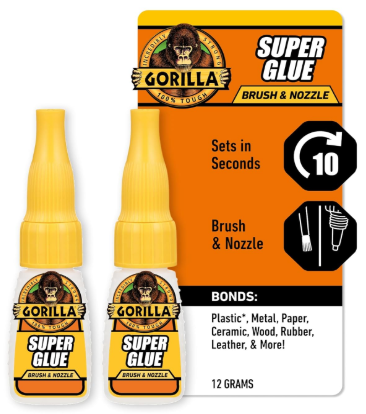
Description:
Gorilla Super Glue Brush & Nozzle is a fast-drying, clear adhesive designed for quick repairs on various surfaces, including ceramics. It features a unique brush and nozzle applicator for precise application.
Key Features:
- Dries in 10 to 45 seconds
- Clear finish
- Includes both brush and nozzle applicators
- Bonds to ceramic, metal, wood, rubber, and more
Pros:
- Quick setting time
- Versatile for multiple materials
- Easy-to-use applicators
Cons:
- Not food-safe
- Strong odor when wet
- Requires careful application to avoid mess
Recommendation:
Ideal for small, non-food-contact ceramic repairs where speed and precision are essential.
2. J-B Weld ClearWeld Quick-Setting Epoxy
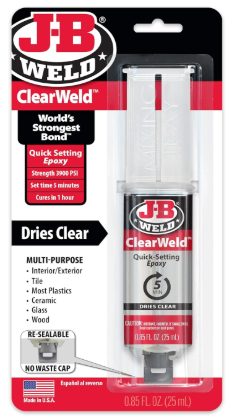
Description:
J-B Weld ClearWeld is a two-part epoxy that sets in 5 minutes and cures in 1 hour, providing a strong, clear bond suitable for ceramic repairs.
Key Features:
- Sets in 5 minutes, cures in 1 hour
- Clear finish
- Water-resistant
- Drillable, sandable, and paintable when cured
Pros:
- Strong, durable bond
- Fast-setting
- Versatile for various applications
Cons:
- Requires mixing of two components
- Short working time after mixing
- Not suitable for flexible materials
Recommendation:
Best for structural ceramic repairs where strength and durability are paramount.
3. Loctite Super Glue Liquid Precision
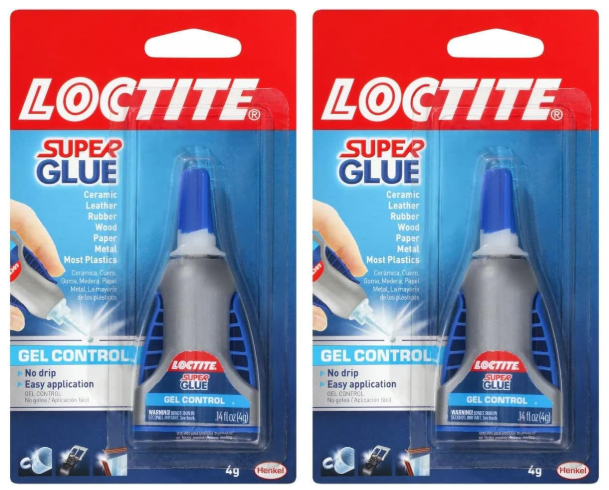
Description:
Loctite Super Glue Liquid Precision offers a precise application with its fine-tip nozzle, making it suitable for detailed ceramic repairs.
Key Features:
- Fine-tip nozzle for precision
- Dries clear
- Bonds to ceramic, metal, plastic, and more
- Fast-drying
Pros:
- Ideal for small, intricate repairs
- Quick drying time
- No mixing required
Cons:
- Not water-resistant
- Not suitable for high-stress applications
- May not fill gaps effectively
Recommendation:
Perfect for minor ceramic repairs where precision and speed are needed.
4. ATLASBOND Ceramic Glue
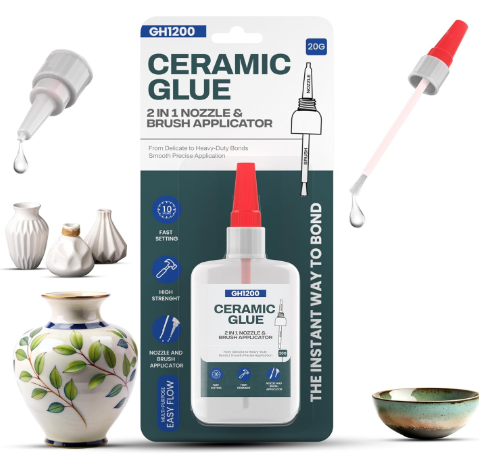
Description:
ATLASBOND Ceramic Glue is a food-safe, heat-resistant adhesive designed for repairing ceramic and porcelain items.
Key Features:
- Food-safe
- Heat-resistant
- Dries clear
- Suitable for ceramic and porcelain
Pros:
- Safe for items that come into contact with food
- Strong bond
- Clear finish
Cons:
- Longer curing time
- Requires careful application
- Not suitable for flexible materials
Recommendation:
Ideal for repairing ceramic cookware or dishes where food safety is a concern.
5. Viomis 30g Ceramic Super Glue
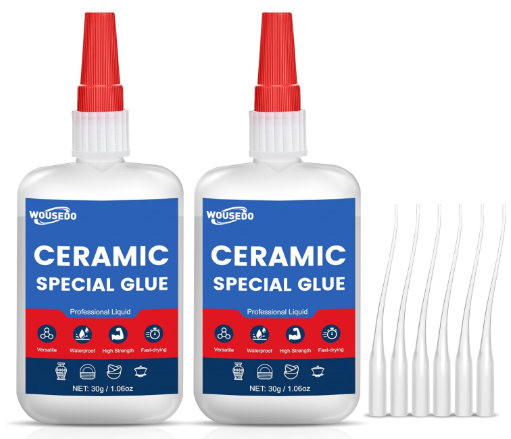
Description:
Viomis 30g Ceramic Super Glue is a fast-drying, waterproof adhesive suitable for various ceramic repairs.
Key Features:
- Fast-drying
- Waterproof
- High bonding strength
- Suitable for porcelain and pottery
Pros:
- Quick setting time
- Water-resistant
- Strong bond
Cons:
- Not food-safe
- Requires careful application
- May not fill gaps effectively
Recommendation:
Best for outdoor ceramic repairs or items exposed to moisture.
6. Kintsugi Repair Kit Gold & Silver
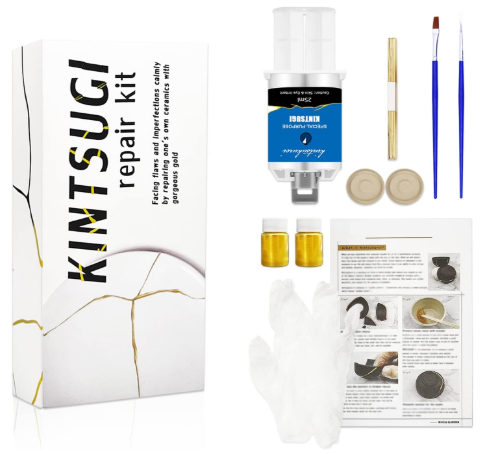
Description:
The Kintsugi Repair Kit offers a unique approach to ceramic repair, using gold or silver adhesive to restore broken items with an artistic touch.
Key Features:
- Includes gold and silver adhesives
- Food-safe
- Suitable for bowls, cups, and vases
- Ideal for beginners
Pros:
- Adds an artistic element to repairs
- Safe for food-contact items
- Easy to use
Cons:
- Not suitable for structural repairs
- May not provide a strong bond for heavy items
- Requires careful application for aesthetic results
Recommendation:
Perfect for decorative ceramic repairs where aesthetics are as important as functionality.
Comparison Table:
| Product | Type | Food-Safe | Heat-Resistant | Drying Time | Best For |
|---|---|---|---|---|---|
| Gorilla Super Glue Brush & Nozzle | Super Glue | No | No | 10-45 sec | Quick, small repairs |
| J-B Weld ClearWeld Quick-Setting Epoxy | Epoxy | No | Yes | 5 min | Structural repairs |
| Loctite Super Glue Liquid Precision | Super Glue | No | No | Fast | Precision applications |
| ATLASBOND Ceramic Glue | Ceramic Glue | Yes | Yes | Moderate | Food-contact items |
| Viomis 30g Ceramic Super Glue | Super Glue | No | Yes | Fast | Outdoor/moisture-exposed items |
| Kintsugi Repair Kit Gold & Silver | Artistic Adhesive | Yes | No | Variable | Decorative, aesthetic repairs |
Final Thoughts:
Choosing the right adhesive for your ceramic repair depends on the specific requirements of your project, such as the need for food safety, heat resistance, drying time, and aesthetic considerations. For quick, small repairs, Gorilla Super Glue Brush & Nozzle offers speed and precision. For structural integrity, J-B Weld ClearWeld Quick-Setting Epoxy provides a strong bond. If food safety is a priority, ATLASBOND Ceramic Glue is a suitable choice. For artistic, decorative repairs, the Kintsugi Repair Kit Gold & Silver adds a unique touch. Consider your specific needs to select the best glue for your broken ceramic items.
| Product | Type | Food-Safe | Heat-Resistant | Drying Time | Best For |
|---|---|---|---|---|---|
| Gorilla Super Glue Brush & Nozzle | Super Glue | No | No | 10–45 sec | Quick, small repairs |
| J-B Weld ClearWeld Quick-Setting Epoxy | Epoxy | No | Yes | 5 min | Structural, heavy-duty repairs |
| Loctite Super Glue Liquid Precision | Super Glue | No | No | Fast | Precision or intricate repairs |
| ATLASBOND Ceramic Glue | Ceramic Glue | Yes | Yes | Moderate | Food-contact ceramic items |
| Viomis 30g Ceramic Super Glue | Super Glue | No | Yes | Fast | Moisture-exposed or outdoor items |
| Kintsugi Repair Kit Gold & Silver | Artistic Adhesive | Yes | No | Variable | Decorative or aesthetic repairs |
This table provides a quick glance at type, food safety, heat resistance, drying time, and best use case to help you choose the most suitable glue for your ceramic repair.
If you want, I can now write the “How to Use & Safety Guide” for these ceramic glues next. Do you want me to do that?
How to Use Ceramic Glue
- Prepare the Surface:
- Clean the broken ceramic pieces thoroughly.
- Remove dust, grease, or old adhesive residues with rubbing alcohol or warm, soapy water.
- Dry completely before applying glue.
- Dry Fit the Pieces:
- Before applying glue, fit the broken pieces together to understand their proper alignment.
- This ensures a precise repair and avoids errors once the adhesive is applied.
- Apply the Glue:
- For super glue or liquid adhesives, apply a thin layer to one surface.
- For epoxy, mix the two components in equal amounts and apply immediately.
- For gap-filling glues, such as polyurethane or some ceramic adhesives, you can slightly overfill to account for shrinkage.
- Join the Pieces:
- Press the pieces together firmly.
- Hold in place for the time recommended by the manufacturer (usually a few seconds for super glue, a few minutes for epoxy).
- Clamp or Support (if needed):
- For larger or heavier items, use clamps, rubber bands, or tape to hold the pieces in place while the glue cures.
- Allow to Cure:
- Follow the recommended curing time.
- Avoid moving or stressing the item during this period.
- Super glue usually sets quickly, but epoxy or food-safe adhesives may require several hours.
- Clean Excess Glue:
- Wipe off any excess glue immediately using a damp cloth or a cotton swab before it hardens.
- For hardened glue, gently scrape or sand it after curing if needed.
Safety Guide for Using Ceramic Glue
- Work in a Well-Ventilated Area:
- Many adhesives emit fumes. Open windows or use fans to avoid inhaling chemicals.
- Wear Protective Gear:
- Gloves prevent skin contact with glue.
- Eye protection is recommended, especially when working with epoxy or adhesives under pressure.
- Avoid Skin Contact:
- Super glue bonds instantly; avoid touching glue with fingers.
- If glue sticks to skin, soak in warm soapy water and gently peel off.
- Keep Away from Children and Pets:
- Store adhesives in a secure location.
- Small ceramic shards and glue can be hazardous.
- Avoid Food Contamination:
- Only use food-safe glues on items that will contact food.
- Do not use standard super glue on dishes, cups, or utensils.
- Proper Storage:
- Seal glue containers tightly after use.
- Store in a cool, dry place away from sunlight and heat sources.
- Follow Manufacturer Instructions:
- Always read the label for drying time, curing, and any special precautions.
- Using glue incorrectly can result in weak bonds or damage to the ceramic item.
Frequently Asked Questions (FAQs)
1. General Questions
Q1: What is the strongest glue for broken ceramic?
A: Epoxy adhesives like J-B Weld ClearWeld provide the strongest and most durable bonds, ideal for heavy or structural repairs.
Q2: Can I use super glue for ceramic repairs?
A: Yes, super glue works well for small cracks or decorative items. However, it may not fill gaps and is less durable for heavy-duty repairs.
Q3: Can I repair a broken ceramic mug or plate with regular glue?
A: Only if the glue is food-safe and heat-resistant, like ATLASBOND Ceramic Glue. Regular super glue is not safe for food-contact items.
2. Application Questions
Q4: How long should I wait before using a glued ceramic item?
A: It depends on the adhesive:
- Super glue: usually fully set in minutes
- Epoxy: 1–24 hours to cure completely
- Food-safe ceramic adhesives: check manufacturer instructions
Q5: Can I glue a ceramic item that has multiple broken pieces?
A: Yes, but start by gluing the largest pieces first and gradually add smaller fragments. Ensure each piece aligns correctly.
Q6: Is it safe to use glued ceramics in a microwave or dishwasher?
A: Only if the adhesive is specifically labeled microwave-safe or dishwasher-safe. Most standard glues are not.
3. Safety Questions
Q7: Are all ceramic glues toxic?
A: Not all. Super glue and epoxy can emit fumes and are not safe for ingestion, while some adhesives like ATLASBOND or Kintsugi kits are food-safe. Always read the label.
Q8: How do I remove excess glue from ceramic?
A: Wipe immediately with a damp cloth before it hardens. For cured glue, carefully scrape or sand the excess.
Q9: Can I use ceramic glue on other materials?
A: Many adhesives work on multiple surfaces such as metal, glass, and wood. Check the product label to confirm compatibility.
Q10: How do I store leftover glue?
A: Seal the container tightly, store in a cool, dry place away from children, pets, and direct sunlight.
Conclusion
Repairing broken ceramics doesn’t have to mean throwing away cherished items. With the right adhesive, you can restore both the functionality and appearance of your ceramic pieces.
- Super glues like Gorilla Super Glue and Loctite Precision are perfect for quick, small repairs.
- Epoxies like J-B Weld ClearWeld offer strong, durable bonds for heavy or structural items.
- Food-safe adhesives such as ATLASBOND Ceramic Glue are essential for kitchenware or items that contact food.
- Artistic repair kits, like the Kintsugi Gold & Silver kit, allow for decorative, aesthetic restoration that transforms broken ceramics into beautiful pieces of art.
When choosing the best glue, consider bond strength, drying time, heat resistance, food safety, and gap-filling ability. Following proper usage and safety guidelines ensures your repaired ceramics are safe, durable, and visually appealing, preserving both their utility and sentimental value.